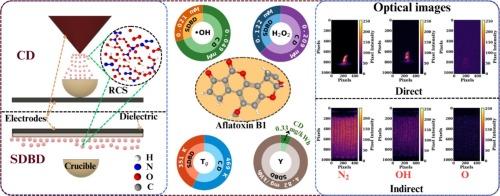Removal of Aflatoxin B1 from solid and liquid matrices using cold atmospheric plasma reactors: Insights into reactor configurations and food quality testing
IF 6.8
1区 农林科学
Q1 FOOD SCIENCE & TECHNOLOGY
Innovative Food Science & Emerging Technologies
Pub Date : 2025-08-26
DOI:10.1016/j.ifset.2025.104203
引用次数: 0
Abstract
The study describes the distinct performance of surface dielectric barrier discharge (SDBD) and corona discharge (CD) in removing aflatoxin B1 (AF B1) from solid surfaces and liquid. Reactive chemical species (RCS) generated within these reactors were thoroughly characterized using chemical probe methods, optical emission spectroscopy (OES), and optical imaging. Optical imaging of the CD reactor confirmed higher emission intensities for key RCS transitions, including the OH rotational band at 308.4 nm, N2 second positive system between 330 and 380 nm, and O at 777 nm. Water sample analysis indicated greater RCS production in the CD reactor (0.21 mM H2O2 and 0.05 mM •OH) compared to the SDBD reactor (0.12 mM H2O2 and 0.02 mM •OH). The optical imaging showed that CD generated more intense but spatially localized RCS, while SDBD exhibited a low-intensity but more uniform RCS distribution over a larger plasma area. Despite these differences, both reactors achieved comparable AF B1 degradation in liquid. Notably, SDBD outperformed in removing AF B1 from solid surfaces, delivering an order of magnitude higher energy yield. The reactors generate reactive species like •OH, H2O2, O3, 1O2, and other oxygen- and nitrogen-containing compounds, which facilitate AF B1 degradation. Among these, •OH radicals are especially important due to their high oxidation potential and non-selective reactivity. The study also assessed the impact of plasma exposure on peanuts. Exposure to SDBD caused negligible changes in the appearance of peanuts, whereas CD treatment resulted in noticeable alterations in color and texture. The findings suggest that reactors like SDBD, which produce a uniform RCS distribution over a broader area, are safer and more effective for decontaminating AF B1 on solid food samples such as peanuts.

使用冷常压等离子体反应器从固体和液体基质中去除黄曲霉毒素B1:反应器配置和食品质量检测的见解
研究了表面介质阻挡放电(SDBD)和电晕放电(CD)在去除固体表面和液体表面黄曲霉毒素B1 (afb1)方面的不同性能。利用化学探针方法、光学发射光谱(OES)和光学成像技术对这些反应器中产生的反应性化学物质(RCS)进行了全面表征。CD反应的光学成像证实了关键RCS跃迁的高发射强度,包括308.4 nm的OH旋转带(A2Σ+→X2Π), 330 ~ 380 nm的N2秒正体系(C3Πu→B3Πg)和777 nm的O (2s22p34S03s5S2−2s22p34S03p5P1,2,3)。水样分析表明,与SDBD反应器(0.12 mM H2O2和0.02 mM•OH)相比,CD反应器(0.21 mM H2O2和0.05 mM•OH)的RCS产量更高。光学成像结果表明,CD产生的RCS强度更大,但空间定位,而SDBD在更大的等离子体区域内产生的RCS强度较低,但分布更均匀。尽管存在这些差异,但两种反应器在液体中都实现了相当的AF B1降解。值得注意的是,SDBD在去除固体表面的AF B1方面表现出色,能量产量提高了一个数量级。反应器产生活性物质,如•OH、H2O2、O3、1O2等含氧和含氮化合物,促进AF B1的降解。其中,•OH自由基因其高氧化电位和非选择性反应活性而尤为重要。该研究还评估了血浆暴露对花生的影响。暴露于SDBD对花生外观的影响可以忽略不计,而CD处理导致花生颜色和质地的明显变化。研究结果表明,像SDBD这样的反应器在更广泛的区域内产生均匀的RCS分布,对于去除花生等固体食物样品上的AF B1更安全、更有效。
本文章由计算机程序翻译,如有差异,请以英文原文为准。
求助全文
约1分钟内获得全文
求助全文
来源期刊
CiteScore
12.00
自引率
6.10%
发文量
259
审稿时长
25 days
期刊介绍:
Innovative Food Science and Emerging Technologies (IFSET) aims to provide the highest quality original contributions and few, mainly upon invitation, reviews on and highly innovative developments in food science and emerging food process technologies. The significance of the results either for the science community or for industrial R&D groups must be specified. Papers submitted must be of highest scientific quality and only those advancing current scientific knowledge and understanding or with technical relevance will be considered.

 求助内容:
求助内容: 应助结果提醒方式:
应助结果提醒方式:


